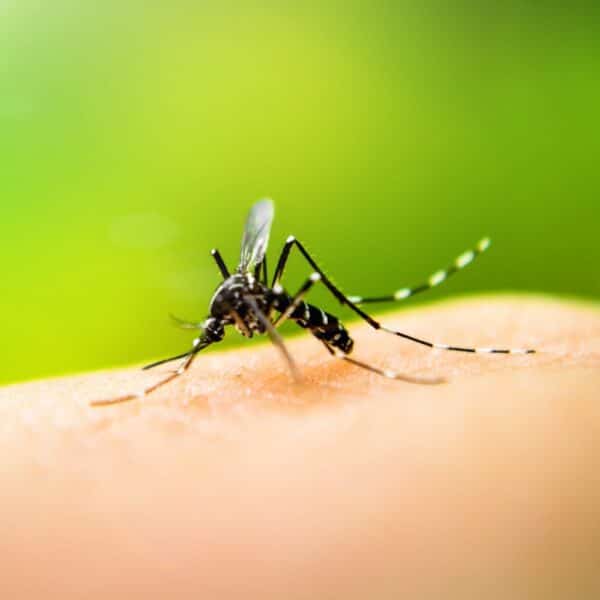Related to flies and gnats, mosquitoes are undoubtedly one of the most-dreaded pests for humans, not only as a disruption to outdoor activities but as vector pests that spread disease. Mosquitoes readily pick up parasites and blood-borne illnesses when gathering the blood of infected mammals, transmitting the parasites through their mouthparts when going from one victim to the next. Here in the United States, including the metro Atlanta area, types of encephalitis, particularly West Nile Virus, are commonly transmitted by Asian tiger mosquitoes, which transmit the disease from infected avian carriers and pass it along to human hosts.
Size: 1/2 in.
Color: Brown with white markings on legs
Body Structure: Slender bodies with long legs, veined wings and a long proboscis (mouthparts) characterized by white markings
Characteristics: Mosquitoes will breed anywhere there is water standing dormant for three days or more. Female mosquitoes are capable of laying up to 3,000 eggs in a lifetime. Generally, the lifespan of a mosquito is 2-3 weeks total. Eggs hatch approximately 24-48 hours after they are laid and release larva, which often can be seen wiggling and floating just above the surface of infested water. As larva, mosquitoes feed upon organic detritus and microorganisms. Within 10 days, larva enter the pupal stage, often referred to as the “tumbler” stage because of the curved cocoon surrounding the pupa. In this stage, mosquitoes breathe through siphon tubes at the surface of the water and cease feeding. After 2 days, the fully-formed adult sheds its pupal skin and spends 24-48 hours drying itself on the surface of the water before beginning the search for food, locating victims through a highly-developed sense of smell and thermal receptors on their antennae. Only female mosquitoes bite animal victims, collecting blood protein to feed developing eggs; mosquitoes do not get their nourishment from blood itself. Adult male mosquitoes feed only on plant nectar and detritus.
Habitat/Behavior: In nature, mosquitoes will be found near ponds, marshy areas or any area of standing water after flooding rains. Mosquitoes also invade domestic spaces where there is standing water. This can range from empty containers and birdbaths to old tires that have collected rainwater. As noted above, only the female mosquito will bite mammalian victims, using its long mouthparts to inject the victim with anticoagulant, which prevents clotting and allows the mosquito to feed freely. The red, white-ringed welt that arises from a mosquito bite is the result of an allergic reaction to the mosquito anticoagulant.
Commonly Active: Spring to Autumn
Prevention/Treatment: To prevent mosquito infestation, make sure your yard is free of objects like old tires or any container that can retain rainwater. If you have decorative receptacles like birdbaths in your yard, make sure to empty them from standing water to prevent mosquitoes from breeding. Because mosquitoes are vector pests that carry disease, keeping your yard free and clear of the insects should be high priority. That said, many store-bought repellents and treatments may offer varying levels of effectiveness. Likewise, they should be administered with extreme caution, especially if you have small children or pets. If you are battling mosquitoes, it is recommended that you contact a pest control professional to determine the best course of action for your household.

